new posts in all blogs
Viewing: Blog Posts Tagged with: fairytales, Most Recent at Top [Help]
Results 1 - 25 of 54
How to use this Page
You are viewing the most recent posts tagged with the words: fairytales in the JacketFlap blog reader. What is a tag? Think of a tag as a keyword or category label. Tags can both help you find posts on JacketFlap.com as well as provide an easy way for you to "remember" and classify posts for later recall. Try adding a tag yourself by clicking "Add a tag" below a post's header. Scroll down through the list of Recent Posts in the left column and click on a post title that sounds interesting. You can view all posts from a specific blog by clicking the Blog name in the right column, or you can click a 'More Posts from this Blog' link in any individual post.
Snow White by Matt Phelan is a breathtaking version of the Grimm tale of treachery and vanity.
Set in New York City during the Great Depression, Phelan removes almost all of the magic and keeps the evil and the charm.
Samantha (Snow) White's new stepmother is the Queen of the Follies - Ziegfeld's Follies. As soon as she enters Snow's family, she banishes Snow to boarding school. Then the new wife engineers the death of Snow's father, the King of Wall Street, to seize hold of his vast fortune, one of the few that remain after the Crash of 1929.
Phelan's gray scale drawings (with a breath of color and splashes of red) are full of emotion and action. (Cue swirling ominous music....)
December is a month of darkness, hearth sides, magic. It's a time to tell tales and imagine what else might exist in the cold. Gnomes, trolls, fairies made of snow flakes - imps that write on our attic windows while we sleep - as the lights come on, all those things might be true - out there - in the dark.
My favorite fairy tale -
East of the Sun, West of the Moon - takes place in the winter and stars a polar bear, a peasant girl and trolls. Just about perfect. The link will lead you to 44 retellings of this story.
Another winter story that haunts me is the Cinderella-like folktale
The Twelve Months or
Strawberries in the Snow. Marushka - and her name varies in the retellings - lives with her aunt and cousins (or sisters and stepmother) - and is treated cruelly. She is sent out in the dead of winter to find fresh strawberries. (One link will lead you to Rafe Martin's retelling; the other, to a whole Pinterest page of illustrations.)
Winter tales belong to the
D'Aulaires. Their books are full of creatures and mythology of the North. Scratchy colorful paintings offer stories of strange beings like ...trolls. Look for their books at your public library. Whenever I think of winter fairytales, Ingri and Edgar Parin D'Aulaire spring to mind.
 Credit where credit is due, there’s no way I could keep up this 31 Days, 31 Lists series if I hadn’t put in my time with New York Public Library. It was there that I learned precisely how to read, track, remember, and call forth the books I read in a single year. The 100 Books List the library puts out every year proved to be my training grounds. I loved working on that list committee. I also loved how that list was separated. One section was always dedicated to Fairy Tales and Folktales, and I’ve maintained the tradition here.
Credit where credit is due, there’s no way I could keep up this 31 Days, 31 Lists series if I hadn’t put in my time with New York Public Library. It was there that I learned precisely how to read, track, remember, and call forth the books I read in a single year. The 100 Books List the library puts out every year proved to be my training grounds. I loved working on that list committee. I also loved how that list was separated. One section was always dedicated to Fairy Tales and Folktales, and I’ve maintained the tradition here.
A generation ago, fairy tales and folktales were ubiquitous. Because libraries made up a significant share of the book buying market, they could set the terms. And what they liked were fairy and folktales. The publishing industry complied and life was good. The rise of big box stores, to say nothing of the internet, heralded the end of the fairy/folktale era. With libraries only a fraction of the buying force, the picture book became king and the fairy and folktales almost disappeared entirely. It’s only in the last few years that small publishers have picked up the slack. While The Big Six become The Big Five soon to be The Big Four, small independent publishers are daring to do what the big guys won’t. Publishing these books has become a kind of rebellion with kids reaping the benefits.
Here are the good books of 2016!
2016 Fairy Tales / Folktales
Babushka: A Christmas Tale by Dawn Casey, ill. Amanda Hall
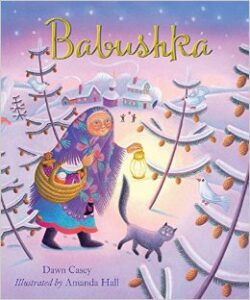
I wouldn’t be surprised if I learned that there was a small running debate as to whether the story of the kind-hearted Babushka was strictly considered to be a folktale. I think it is, and I think it’s great. And the perfect book to read before the holiday season as well!
Beauty and the Beast retold by Mahlon F. Craft, ill. Kinuko Y. Craft
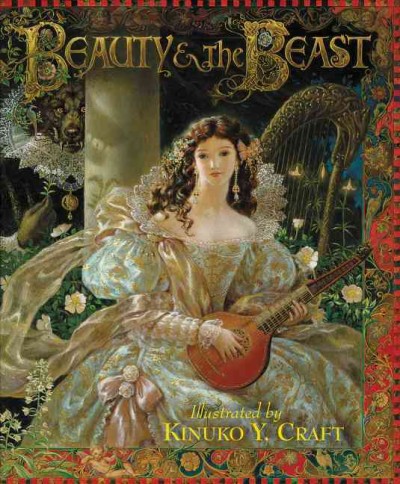
Hooray! A new Craft!! How long has it been? Whatever the case, Craft was always the illustrator I’d turn to when I got small patron insisting on “Pretty fairytales”. Which, as I soon learned, was a desire that could easily be satisfied by just handing the kid one of Craft’s books. No one was quite as consistently appealing as Craft.
The Blue Jackal by Shobha Viswanath, ill. Dileep Joshi
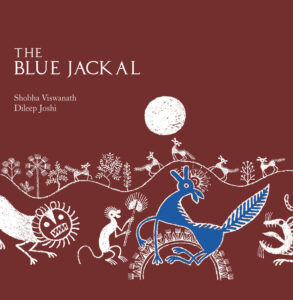
Caterpillar Woman by Nadia Sammurtok, ill. Carolyn Gan
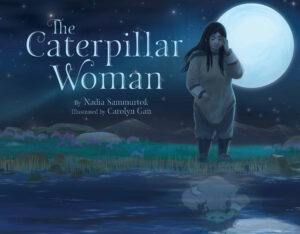
Inhabit Media is a small publisher that consistently puts out remarkable Inuit stories. There were quite a few in 2016 but this one stood out as my favorite. I like it for its flaws. Not in spite of them.
Dwarf Nose by Wilhelm Hauff, ill. Elizabeth Zwerger
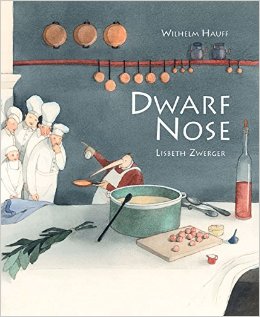
Technically this book is a reprint. Technically I don’t care. I love the disjointed nature of their story. I love that the villain’s name is Herbwise. And, naturally, I like the unexpected ending.
Farmer Falgu Goes on a Trip by Chitra Soundar, ill. Kanika Nair
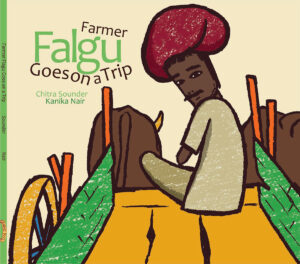
Consider it a version of Zemach’s It Could Always Be Worse.
First Light, First Life: A Worldwide Creation Story by Paul Fleischman, ill. Julie Paschkis.
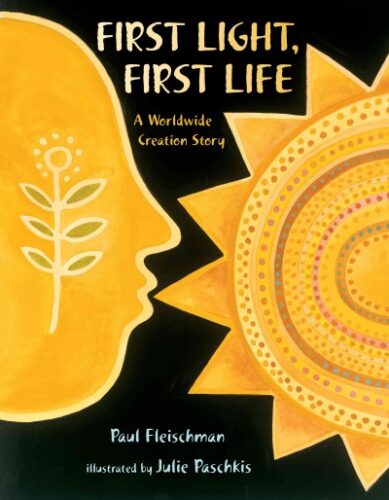
Fleischman and Paschkis paired once before to collect worldwide stories and song and riddles and rhymes in a Cinderella Story. Now he’ coming back and there’s going to be girls.
Hare and Tortoise by Alison Murray
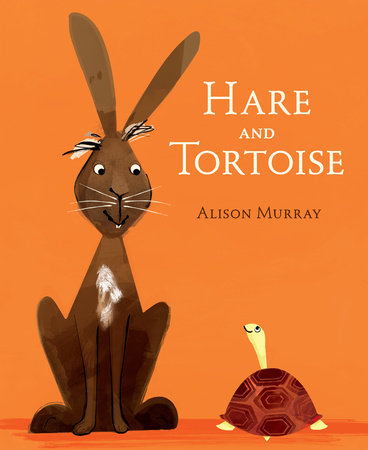
We don’t have a lot on this list for kids that are below the ages of 6. Here’s one they’ll ask for again and again.
I Am Pan! by Mordicai Gerstein
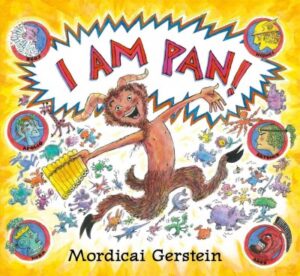
A little Greek mythology never hurt anyone. And who knew that Gerstein had this much stamina in him? This thing writes, pops, jumps, and does a tapdance on your head, if you let it.
Little Red by Bethan Woollvin

Everyone appears to be just GAGA about this work! The red, black, and white and near wordless plotting work in terms. A lovely retelling.
The Pied Piper of Hamelin by Thomas Baas
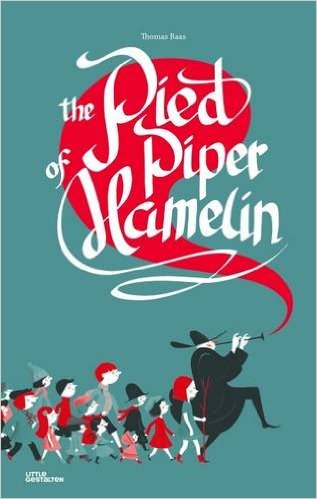
A Word of Warning: If you don’t care for rats, this may not be the book for you. But just look at those colors! Gorgeous.
Prince of Fire: The Story of Diwali retold by Fatinder Verma, ill. Nilesh Mistry

Insofar as I can tell there hasn’t been a definitive Diwali origin published in at least 10 years.
The Princess and the Warrior: A Tale of Two Volcanoes by Duncan Tonatiuh
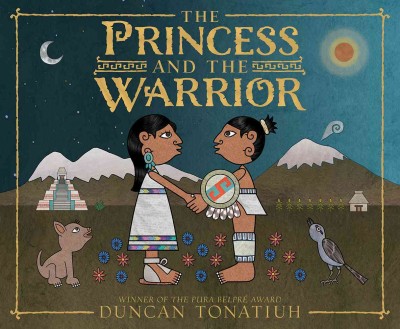
Come to think of it, warriors don’t tend to marry princesses in love stories. That’s okay. It’s still a cool tale.
The Singing Bones by Shaun Tan

Snippets of Grimm stories are paired with Tan’s remarkable interior models and photography. Creepy beautiful, if that’s a thing.
The Steadfast Tin Soldier by Hans Christian Andersen, retold and illustrated by Joohee Yoon

It’s the original story, which is to say it’s just as depressing as you remembered. Still, the typography, design and colors are superb.
Tales from the Arabian Nights: Stories of Adventure, Magic, Love, and Betrayal by Donna Jo Napoli, ill. Christina Balit

That would be the winner of the Best Tagline award. Well done.
Thumbelina by Xanthe Gresham Knight, ill. Charlotte Gastaut
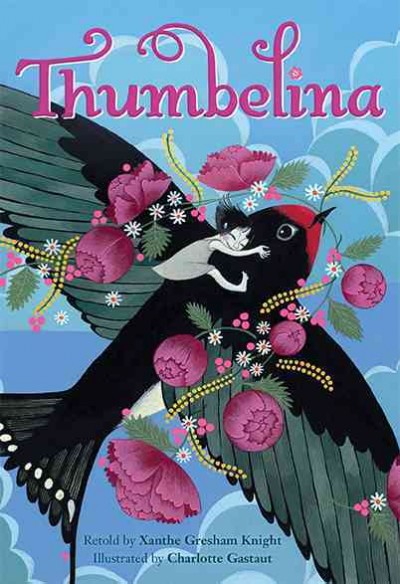
Oh, it’s so good! I’ve always been very concerned with the mother that Thumbelina abandons in this story. This book, for the very first time in my experience, tackles that loose end head-on. Woohoo!
Vasilisa the Beautiful: A Russian Folktale by Anna Morgunova

There’s a bit of Klimpt to the art here, I’ll admit it.But otherwise I’d say that the book is an original. Love the retelling, adore the art, and I hope the kids appreciated it.
Interested in the other lists of the month? Here’s the schedule so that you can keep checking back:
December 1 – Board Books
December 2 – Board Book Adaptations
December 3 – Nursery Rhymes
December 4 – Picture Book Readalouds
December 5 – Rhyming Picture Books
December 6 – Alphabet Books
December 7 – Funny Picture Books
December 8 – Calde-Nots
December 9 – Picture Book Reprints
December 10 – Math Picture Books
December 11 – Bilingual Books
December 12 – International Imports
December 13 – Books with a Message
December 14 – Fabulous Photography
December 15 – Fairy Tales / Folktales
December 16 – Oddest Books of the Year
December 17 – Older Picture Books
December 18 – Easy Books
December 19 – Early Chapter Books
December 20 – Graphic Novels
December 21 – Poetry
December 22 – Fictionalized Nonfiction
December 23 – American History
December 24 – Science & Nature Books
December 25 – Transcendent Holiday Titles
December 26 – Unique Biographies
December 27 – Nonfiction Picture Books
December 28 – Nonfiction Chapter Books
December 29 – Novel Reprints
December 30 – Novels
December 31 – Picture Books


By: Kenneth Kit Lamug,
on 2/29/2016
Blog:
RabbleBoy
(
Login to Add to MyJacketFlap)
JacketFlap tags:
nevada scbwi,
game on,
kidlitart,
kids literature,
scary books for kids,
awards for kids,
black skulls,
creepy art,
creepy picture book,
freebook,
grimm fairytale,
halloween scary book,
kids rewards,
las vegas art exhibit,
las vegas author,
las vegas author group,
las vegas illustrator,
las vegas scbwi,
mothergoose stories,
perfect halloween book,
purchase book,
rick rowe,
scary picture book,
the stumps of flattop hill,
kidlit,
Book Reviews,
book review,
drawing,
children's literature,
book giveaway,
Press,
Children's Picture Books,
children's literacy,
free book,
fairytales,
books for kids,
society of children's book writers and illustrators,
edward gorey,
tim burton,
author giveaway,
Vulpes Libris,
Add a tag
Good art can be a little dark and disturbing. In the case of a new exhibition at the Whitney Library Gallery, it can also be classified as creepy, spooky, kooky, mysterious and more than a little fun. The show features dark drawings and haunting images, much of them from a new children's book, "The Stumps of Flattop Hill," by Las Vegas-based author Kenneth Kit Lamug.
By Nick Cross
After 13 years, 14 Eisner Awards, 150 issues and almost 6,000 pages, the Vertigo comic book series
Fables has reached its end. What began as a simple postmodern twist on fairy tales quickly evolved into a sprawling, beautiful, dark, engrossing, ambitious and occasionally frustrating saga. As I closed the cover on the final volume, I felt both exhilaration and the sad pang of loss. Under those circumstances, it seemed only fitting to introduce this tremendous grown-up comic series to a wider audience and also take the opportunity to explore the challenge of writing truly long-form stories.
Read more »
Bianca Dalmatin wants for nothing. As the heir to a department store empire and stepdaughter of the beautiful Lady Belladonna, the only thing Bianca longs for is a friend. It seems that her wish is granted at the Duke's Presentation Ball when she meets the handsome, mysterious Lucian Montresor.
But after the Mirror newspaper names Bianca as Lepmest's new Fairest Lady, the true nature of her stepmother is revealed. Belladonna tells Bianca the shocking news that Bianca's father is dying – and, when Bianca races to be by his side, Belladonna sends her faithful servant to kill her.
Who is friend and who is enemy? Plunged into a terrifying world that will turn her from a daughter of privilege to a hunted creature in fear of her life, Bianca must find allies if she is to survive – and if she is to expose Belladonna for who she really is...
This is Sophie Masson's Snow White novel, set in the same universe as her Cinderella novel, Moonlight And Ashes, in the Faustine Empire, in the same Victorian/Edwardian era, with telegrams and steamers. There are also trams, presumably horse drawn. Her Snow White, Bianca, is the daughter of "The King Of Elegance" instead of a regular king. The Mirror is a newspaper instead of an actual mirror, though there is a reference to it in the fashion show at the beginning. There is definitely magic involved as well as technology, there's a Prince of a kind and there's even that glass coffin, though I won't tell you more, because spoilers ...
Like Moonlight And Ashes it starts with the fairytale and continues past that. Unlike Ms Masson's Cinderella, Selena, whom you know will be strong right from the beginning, Bianca starts as an ordinary teenage girl who admires her beautiful and elegant stepmother, Belladonna, right up till the lady tries to have her killed. In the course of the novel, she realises that she needs to be stronger if she is to defeat Belladonna, and does some good investigation of the mystery behind the woman who snared her father. She makes some huge mistakes - mistakes that can get people killed, not only herself but the truly wonderful friends she has made along the way, but somehow her very klutziness results in a better outcome than if she had done the sensible thing.
Young readers of this may be a little disappointed in some of the romance elements but all I can say is that there were hints early on and it all works out in the end.
This is my second fairytale adaptation reading of the last week, by another of Australia's top fairytale adapters. I wonder if there's anything new by Juliet Marillier in the fairytale area? Hmm...
When I was a youngster, I remember reading Mollie Whuppie in one of the many fairytale collections at the public library. I am a fairytale kind of person. Mollie Whuppie is a little short on sparkles and ball gowns and a little long on violence and greed.
I don't know why I like the story so much. It may be the archaic dialog between Mollie and the giant she torments. It might be that Mollie is an unexpected hero - the runt of the family, and a girl to boot.
When I figure it out, I'll let you know. I have to admit, I did not tell the original ending. That ending is a bit too gruesome for my tastes.
Today, I decided to share Mollie Whuppie with the sixth graders at Nazareth Intermediate School. My version has some (ahem) blood in it and there's lots of action. I guessed, correctly, that the guys would like it. What I didn't expect was all the questions the kids had during and after the story. One question that cropped up in three of the four classes was this. "How did the King know what the Giant had and where he kept it?"
Yeah! How did he know that? And why did he keep sending this tiny girl out to steal from the Giant? And why did the parents abandon the three youngest children and not the three oldest children - who might have a better chance of surviving?
And why did Mollie carry the treasures back to the King? Why not keep them for herself?
And why didn't those old time storytellers ask these questions themselves and answer them in the story? (My question.)
Perhaps Kings were such powerful people that listeners at the time thought Kings knew what everyone had and where they kept it. I bet that they felt that way at tax time.
And powerless people always like stories about small powerless people who prevail.
Now, about keeping the loot for herself, Mollie had to protect her sisters who might suffer at the hands of the King if Mollie "cheated" him.
As to abandoning the youngest rather than the oldest, I invite you to offer reasons for that.
In the meantime, these questions make great writing prompts and I imagine a comic book series about The Adventures of Mollie Whuppie. Although there are picture books out there starring Ms. Whuppie, she could be a superhero.
Mollie Whuppie, Unexpected Hero!!!
.png.jpg?picon=3640)
By:
Sara Burrier,
on 2/9/2015
Blog:
warrior princess dream
(
Login to Add to MyJacketFlap)
JacketFlap tags:
fairy,
religion,
mythology,
fairies,
disney,
folklore,
belief,
demon,
Christianity,
fairytales,
fae,
faerie,
paganism,
Add a tag
Fairies are a sensitive, but intriguing subject. I come from a background of spell casting, fairy seeking, séances, horned gods/goddesses, priestess', and a mountain of metaphysics.
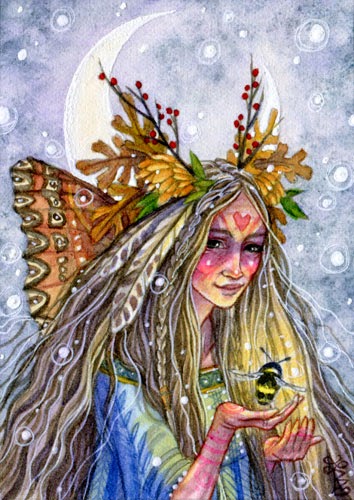 |
| Crone |
I describe that because I want you to hear that I studied fairies. My senior project in college was about fairy folklore and the Celts. I was VERY interested in being a high priestess in the occult, and according to many whom I spent my time with, I was well on my way.
Then Jesus grasped my heart and pulled me up for air. To my surprise, this was a very quick, rather simple and easy transition. Except for a few bumps. One was my belief in fairies.
Now where did the fairy stand? This is what I paint, what I love to paint. What do I believe about them now? What do YOU believe about them?Brian and I were talking about the origins of fairies this past Saturday during a small road trip. I forgot how excited and interested I am in their history, and I hadn't really looked into it again since college. Re-reading about them has sparked my interest as a Christian, and as a professional artist of the fairytale.
This is part one. How many parts will this discussion have? I don't know. Yet I'm so mystified by being a Christian, painting fairies, and all of the gray in the middle, that I can't leave it be.
Here's where we start, the origin of the fairy.
Dictionary.com:
fairies.(in folklore) one of a class of supernatural beings, generally conceived as having a diminutive human form and possessing magical powers with which they intervene in human affairs.
• • • • • • • • • • • • • • • • • • • • • • • • • • • • • • • • • • • • • • • • • • • • • • • • • • • • • • • • • • • • • • • • • • • • • • • • • • • • • • • • • • • • • • • • • • • • • • • • • • • • • • • • • • •
Fairies in Christianity
One Christian belief held that fairies were a class of "demoted" angels.[25] One popular story described how, when the angels revolted, God ordered the gates of heaven shut: those still in heaven remained angels, those in hell became demons, and those caught in between became fairies.[26] Others suggested that the fairies, not being good enough, had been thrown out of heaven, but they were not evil enough for hell.[27] This may explain the tradition that they had to pay a "teind" or tithe to hell: as fallen angels, though not quite devils, they could be seen as subjects of the devil.[28] For a similar concept in Persian mythology, see Peri.
A third, related belief was the fairies were demons entirely.[29] This belief became much more popular with the growth of Puritanism.[30] The hobgoblin, once a friendly household spirit, became a wicked goblin.[31] Dealing with fairies was in some cases considered a form of witchcraft and punished as such in this era.[32] Disassociating himself from such evils may be why Oberon, in A Midsummer Night's Dream, carefully observed that neither he nor his court feared the church bells.[33]
The belief in their angelic nature was less common than that they were the dead, but still found popularity, especially in Theosophist circles.[34][35] Informants who described their nature sometimes held aspects of both the third and the fourth belief, or observed that the matter was disputed.[34]
• • • • • • • • • • • • • • • • • • • • • • • • • • • • • • • • • • • • • • • • • • • • • • • • • • • • • • • • • • • • • • • • • • • • • • • • • • • • • • • • • • • • • • • • • • • • • • • • • • • • • • • • • • •
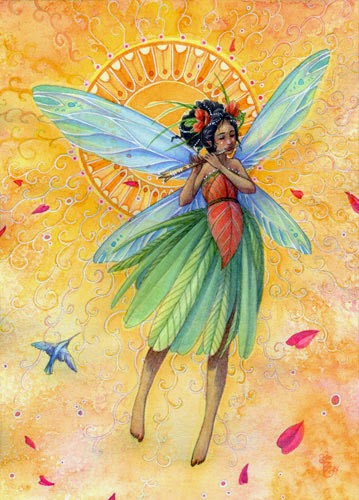 |
| Songs of Summer |
If I'm a Christian then, should I believe this? That fairies are demons? Is what I create demonic or a symbol of the demonic?
Upon further reading on other sites I read this (found on this site):
Evil spirits are like actors. They will take on any role that suits their cause or present climate. If people want angels, they will be angels. Departed loved ones? This is one of their best performances. Fairies? If that’s what people want, and if there are people out there who are seeking them out and want to communicate with them, they will be happy to wear the badge and play the part. The Bible tells us that even Satan himself "... masquerades as an angel of light" (2 Cor. 11:14). However, a demon is a demon and will lie, deceive and lead people astray.
The end result is spiritual bondage and ruin. Demons, in their many guises, will lead you up a very slippery path of deceit and despair, wanting you to focus on them rather than God and the peace and salvation He gives through faith in Jesus Christ.
I can agree that they usually are described having the nature/personality of biblical demons. As much as it pains me to say it. Even as a fairy believer I never saw them (the ones I wanted to see) as demonic, but more elemental to help. Like the ones in
Disney's Fantasia.
• • • • • • • • • • • • • • • • • • • • • • • • • • • • • • • • • • • • • • • • • • • • • • • • • • • • • • • • • • • • • • • • • • • • • • • • • • • • • • • • • • • • • • • • • • • • • • • • • • • • • • • • • • •
I am left chewing on this resounding throughout information, the belief from the Christian religion that all fairies are demons. In a couple of days I hope to share and explain why, then, if this is the belief, are so many fairies painted as bright, sweet, adorable little people? Is it still part of Satan's act to get us to follow him, making them more romantic and captivating? Or is there more to the story?
What is your belief of fairies?
By: C. C. Gevry,
on 9/10/2014
Blog:
The Children's and Teens' Book Connection
(
Login to Add to MyJacketFlap)
JacketFlap tags:
magic,
Young Adult fiction,
Teen fiction,
fairies,
fairytales,
witches,
adventure stories,
Supernatural,
dwarves,
The Children's and Teens Book Connection,
supernatural stories,
Deirdra Eden The Watchers,
Knight of the Light,
Add a tag
 All the training in Heaven couldn’t prepare me for the war on earth, nor for the love, loss, or loneliness humans feel. There are things worse than death, and every last one of them is hunting people like us. Even though we all feel human at times, we must remember, we are not them, we are their watchers.
All the training in Heaven couldn’t prepare me for the war on earth, nor for the love, loss, or loneliness humans feel. There are things worse than death, and every last one of them is hunting people like us. Even though we all feel human at times, we must remember, we are not them, we are their watchers.
In England, 1270 A.D., Auriella (pronounced yurr-ee-ella) flees her village after being accused of witchcraft. Pursued by nightmarish creatures, she struggles to accept the truth about her humanity. Filled with fairies, dwarves, pixies, dragons, demons, and monsters, Knight of Light is an enthralling tale that will capture the imaginations of readers young and old.
The Watchers Series has been described as Braveheart meets Supernatural. The mythology for the series is based on many theological texts from dozens of sects with correlating themes. Ancient writings include the Dead Sea Scrolls, the Traditional Apocrypha, the Pearl of Great Price and the Kabbalah. The Watchers are supernatural beings in human form whose duty it is to protect and guard mankind from the armies of darkness. Unfortunately, as the Book of Enoch mentions, some of these Watchers go bad.
Although the mythology is based on these texts, Deirdra Eden’s, The Watcher’s Series, is written in a traditional fairytale style with a young girl’s discovery of incredible, but dangerous powers within herself, a cast of humorous side-kicks, a quest for greater self-discovery and purpose, and villains of epic proportions.
Paperback: 205 pages
Publisher: Brigham Distributing (July 14, 2014)
Language: English
ISBN-10: 0996015809
ISBN-13: 978-0996015806
Watch the intense new trailer!
Amazon Barnes and Noble Facebook Twitter Goodreads Wattpad Pinterest


Children's books have spawned an excess of silliness in the media lately. First of all there was Ruth Graham's article on Slate, which told its readers, in no uncertain terms that:
"Adults should be ashamed of reading literature written for children".
Oh dear. That's me with my knuckles rapped, then.
The same day, the perennially anti-escapism Richard Dawkins weighed in with his opinions on fantasy and fairytales, saying
"I think it's rather pernicious to inculcate into a child a view of the world which includes supernaturalism".
Now I took issue with Professor Dawkins (aka 'The Frog') on this very subject back in 2008, with a piece called 'Long Live the Fairytale', and I still stand by the words I wrote.
To be honest, I'm just a bit fed up with having to get up and shout against this sort of thing, so I'm not going to go into a long and involved rant here. Luckily for me, there are many other people who can do that far better and more articulately -
Non Pratt (on reading YA) last week, and
Philip Pullman (on Fairytales) back in 2011 - to name just two.
From a personal point of view, I am what might be called an omnivorous reader. Last week it was Jennifer Worth's accounts of midwifery in 1950's London, before that Jung Chang's fascinating biography of the Dowager Empress Cixi, as well as some excellent UKYA by Tanya Landman and Claire McFall - one a historical novel about the American Civil War and the other an almost literally heart-stopping thriller. I read letters, I read diaries (because I'm damned nosy). I read literary novels, I read crap detective stories. I read erotica and travel, politics, the classics and deep, dusty tomes on mythology, ancient religions and shamanism, picture books, chapter books and middle-grade fiction. Even the backs of cereal packets if I'm really desperate (I recommend Rude Health ones).
I write all sorts of different stuff too - from very young picture books about grubby pirates and tree-snipping bears through retellings of old myth and folklore to novels about fairy folk, dragons and ancient queens.
The point I'm trying to make here is that I'm not ashamed of any of it. Not the reading, not the writing - and why the hell would anyone think they have the right to tell me I should be? I LIKE reading YA. It gives me a different sort of reading pleasure to, say, Austen or Tolstoy or Zadie Smith or Donna Tartt or Malcolm Gladwell - but I happen to think that's ok.
Same goes for the writing. I LIKE making weird and fantastical stories up for kids of all ages (including ones about fairies and gods). From the fan-mail I get, and the interactions I have with kids in the schools I visit, I think my readers appreciate it too. In my opinion, fairytales and fantasy feed the mind, they don't corrupt it, and I still don't think Mr Dawkins gives children enough credit for intelligence. What I said back in 2008 is as relevant to me today as it was then, so I'll leave you with this thought:
"A child’s mind is absolutely capable of containing many ‘once upon a times’ and evidential scientific formulae all at the same time—and what’s more, distinguishing entirely successfully between the two without any harmful effects whatsoever."
Stick that where the sun don't shine, Professor. Thanks all the same, but I'd rather listen to Einstein.
"A rollicking story and a quite gloriously disgusting book that children (especially boys) will adore!" Parents In Touch magazine
"A splendidly riotous romp…Miss the Captain’s party at your peril." Jill Bennett
"An early candidate for piratey book of the year!" ReadItDaddy blog
"A star of a book." Child-Led Chaos blog
"A splendid reminder of the wonder of the oldest of stories…should be in every home and classroom" The Bookseller
Lucy's brand-new and sparkly
Website

By:
Jen Robinson,
on 4/10/2014
Blog:
Jen Robinson
(
Login to Add to MyJacketFlap)
JacketFlap tags:
Newsletter,
illustrated books,
fairytales,
pink,
noah z. jones,
Early Elementary School,
early reader,
goldilocks,
female protagonist,
Reviews,
fractured fairy tales,
Add a tag
Book: Princess Pink and the Land of Fake-Believe: Book 1: Moldylocks and the Three Beards
Author: Noah Z. Jones
Pages: 80 (illustrated early reader)
Age Range: 5-7
 Moldylocks and the Three Beards (yes, Beards) is the first book in a new heavily illustrated early chapter book series by Noah Z. Jones called Princess Pink and the Land of Fake-Believe. Princess Pink has seven older brothers, and her parents were so happy to have a girl that they named her "Princess." Their last name is "Pink." She is the exact opposite of her name:
Moldylocks and the Three Beards (yes, Beards) is the first book in a new heavily illustrated early chapter book series by Noah Z. Jones called Princess Pink and the Land of Fake-Believe. Princess Pink has seven older brothers, and her parents were so happy to have a girl that they named her "Princess." Their last name is "Pink." She is the exact opposite of her name:
"Princess Pink does not like fairies. She does not like princesses. And she REALLY does not like the color pink.
Princess Pink does like dirty sneakers, giant bugs, mud puddles, monster trucks, and cheesy pizza."
When her refrigerator turns into a portal to another world one late night, Princess finds herself in the Land of Fake-Believe. Her hair turns pink, but her new friend Moldylocks thinks that it looks cool. Hungry, she sets out with Moldylocks to visit the home of three Beards she knows, in the hope of sneaking some chili. A mix of expected and unexpected events follow, culminating in a daring rescue. And at the end, when Princess is back in her own bed, there's a suggestion that it just might have all been true.
This series is designed to appeal to first and second grades, with a grade 2 reading level. But I have to say that my just-turned four-year-old adores Moldylocks and the Three Beards as a read-aloud. When she realized that it was a satire on Goldilocks and the Three Bears, she didn't quite get it, but she pealed with laughter anyway. She liked trying to predict what would happen next.
But really, I do think this this is going to be a very nice series for new first and second grade readers. It's funny, and just a little gross. (Eating chili that a spider has been bathing in? Yuck! Green, moldy hair? Yuck!) It riffs on standard fairy tale tropes (there's a Mother Moose, for example, with a Tunacorn), and has entertaining illustrations. It's a nice introduction for kids to the concept of fractured fairy tales, and the way that they confound expectations.
Princess is about as non-stereotypical as she she could be, with medium brown skin, ragged shorts, and multi-colored socks. And I have to say, she looks pretty cool with the pink hair. She runs away from the Beards at first, but goes back bravely when her new friend needs her. In short, she's a delightful heroine for the modern primary schooler. And really, despite being about a girl named Princess Pink, the story is certainly boy-friendly, too.
Moldylocks and the Three Bears is something of an early reader/graphic novel hybrid. Much of the story is told through colorful, comic-like pictures and text call-outs. But there's traditional narrative on every page, too. Princess's words are shown in pink, while Moldylocks' are green. The girls are wide-eyed with expressive features. The Beards are a little odd, but funny. The spiders are surprisingly cute. And Moldylocks' green-tinged apron, well, that's a bit gross, but funny, too. The vocabulary is quite straightforward, and should be accessible to second graders. There are plenty of clues in the pictures as to what is going on anyway.
In short, I think that The Land of Fake-Believe series is going to be a nice addition to the ranks of early chapter books. I've even checked online already to see when the next book will be out (not until August, alas). School and public libraries will definitely want to give Moldylocks and the Three Beards a look. Recommended!
Publisher: Scholastic (@Scholastic)
Publication Date: April 29, 2014
Source of Book: Review copy from the publisher
FTC Required Disclosure:
This site is an Amazon affiliate, and purchases made through Amazon links (including linked book covers) may result in my receiving a small commission (at no additional cost to you).
© 2014 by Jennifer Robinson of Jen Robinson's Book Page. All rights reserved. You can also follow me @JensBookPage or at my Growing Bookworms page on Facebook.

At the moment I’m in Crimea: occupied Ukrainian territory/annexed state/proud and permanent part of Russia (delete as your politics deem appropriate).
I’m witnessing Crimea become more and more polarised, closer to breakdown, as everything – food, money, language, family, friends, conscience – is informed by politics. Even children’s stories – perhaps stories first of all. Even fairytales.
Russian fairytales, someone told me today, are characterised by heroes who never do anything to help themselves. It’s all done for them. The stove they lie on gets up and carries them off to fame and fortune, and they win by virtue of being lazy.
I’ve heard this before, and to a certain extent, in some tales, it’s true. As someone who’s quite lazy herself, maybe it’s one reason I’m very fond of Russian fairytales
And that’s the Russian character, this person went on to say. Always expecting something for nothing, unable to act or think for themselves, just thinking they’re entitled. Like all the Russians in Crimea who voted to become part of Russia last week, because they think they’ll get something for nothing, they think they’re entitled to higher pensions and better salaries without putting in any effort, they think they’re entitled to Crimea. Just like in 1944. Just like in 1783…
There is so much propaganda on all sides of this conflict now, no one can begin to see clearly anymore. Even fairytales are press-ganged into the service of politics. So in Crimea now we have the stupid Ukrainians of fairytales, the cunning dishonest Tatars, the lazy entitled Russians… all beginning to hate each other.
I’m fascinated by the universality of fairytales, the way the same paradigms crop up in stories from Central America to the Middle East to Siberia. Desite the cultural differences they represent, I think they grew out of parallel imagination, from common human experience. Fairytales can cross borders and languages and bring people together.
Or they can be used to drive people further and further apart.
.jpeg?picon=3655)
By: alethea aka frootjoos,
on 12/15/2012
Blog:
Read Now Sleep Later
(
Login to Add to MyJacketFlap)
JacketFlap tags:
Fairytales,
netgalley,
kimberlybuggie,
2 stars,
PrincessoftheSilverWoods,
JessicaDayGeorge,
RobinHood,
young adult,
book review,
fantasy,
mythology,
retelling,
Add a tag
Publication Date: 11 December 2012 by Bloomsbury
ISBN 10/13: 1599906465 | 9781599906461
Category: Young Adult Fantasy/Fairytale Retelling
Keywords: Robin Hood, Fairy Tales, Myths
Formats: Hardcover
Source: NetGalley
Kimberly's review:
This is the third book in the series, the last one, the story to tie up all loose ends. Seeing as I haven't read any of the other ones before, I was afraid I might get lost. Thankfully, the history and mythology is carefully explained and it's a twisted history indeed!
Petunia, the youngest of the twelve dancing sisters, is abducted by a "wolf" in the forest, a young man with the mask of a wolf. She finds him to be Oliver, an earl who has lost his land, and has been reduced to robbing passing coaches. Oliver swears to get her to her destination, but when he drops her off at the gates, he realizes that something is wrong and Petunia is in more danger than she realizes. Fairy tales and myths combine for a very cute story.
I really liked the mythology and the history. I think it would have been better to follow the journey from book one, but I didn't have any problems following the thread. It was interesting and imaginative, these interwoven fairy tales. I like Petunia, but she is sixteen so a couple times I rolled my eyes at her. A lot of the book is spent with her eleven sisters, all named after flowers. I'm sure it is hard to write a story about the twelve dancing princesses, but honestly, most of the time I was confused by them. None of them really stood out with a distinct personality. They all blended together.
This goes the same way for Oliver, his band of thieves, and the sisters' husbands. I didn't feel a real connection to any of them. I may have had a different experience if I had read the series from book one.
Overall,
The Princess of the Silver Woods is fun and a clever twist on the stories of the Twelve Dancing Princesses, Robin Hood and Little Red Riding Hood. Fans of fairy tale retellings will enjoy this romp through the forest.
Find out more about the author at
www.jessicadaygeorge.com and follow her @
JessDayGeorge
.jpeg?picon=3655)
By: alethea aka frootjoos,
on 12/7/2012
Blog:
Read Now Sleep Later
(
Login to Add to MyJacketFlap)
JacketFlap tags:
YA,
family,
Siblings,
young adult,
fantasy,
fairies,
Penguin,
Fairytales,
fae,
Dial,
kimberlybuggie,
Add a tag
Publication date: 16 August 2012 by Dial
ISBN 10/13: 0803735804 | 9780803735804
Category: Young Adult Fantasy
Keywords: Family, Fae, Missing Siblings, Fairy Queen
Format: Hardcover, ebook
Source: Borrowed ARC
Kimberly's synopsis and review:The trees swallowed her brother whole. Now Jenny, seven years later, goes back to the place where it happened. To the place she lost her brother, to where she lost her family, to say goodbye. But instead, she hears a mysterious song, reminding her of her brother Tom, and before she knows it, she's in a dangerous world. And she swears she won't leave without her brother.
I'll be honest--this book caught my eye because of the cover. Did you see it? Pretty. And I like a good fairy tale as much as the next girl so I was really looking forward to reading this book.
This is more of a traditional fairy tale. A missing sibling, a family torn apart, and the sister who is the only one who can find him. Jenny wanders through the forest, with a guide named Jack who has his own intentions. Evading the evil queen, ignorant of the rules of this land, Jenny finds herself in scary and dangerous situations. I love the danger that looms on every page. I enjoy the betrayals and dark nature of the characters. There is some beautifully descriptive writing and a couple of fun twists.
Unfortunately, I am not a fan of Jenny. She's supposed to be seventeen, but she seems younger. I'm told she has a pure, good heart, but she falls into the group of uninteresting, bland main characters. She's too good, there's little fire. Oh sure, her guide Jack sees the fire, the stubbornness, the flame. But as a reader, I really didn't see it. I was told. She seemed a rather tame teenager, honestly.
Jack is the most interesting character by far. Conflicted, with multiple allegiances, Jack's motivations are clouded and he has more depth than any of the other characters by far. By the time we meet Tom, Jenny's brother, who has been in the fairy world for seven years, even he is still too vanilla. You'd think being brainwashed, held captive, and possibly going to be a ritual sacrifice would make Tom into a more layered young man, but alas, no. And the other characters don't do fair well either. The motivations behind the kind and queen are thin, but if you look past it, you'll find a fun story and a fast moving plot.
Overall, I liked the story for the plot, for the creepiness and the world. But I couldn't identify with any of the characters. If you like more traditional fairy tales, you'll like this book!
Find out more about the author at
rflong.com and follow her on Twitter @
RFLong.
You can find more of Kimberly's reviews at
The Windy Pages.
I’ve been fascinated by fairy tales and fairy lore for as long as I can remember. Far more than contemporary fiction, as a child it was the tales of Grimm, Arabian Nights and Hans Andersen that really gripped my imagination. My mother had several old collected editions of these tales dating from her own childhood which she only produced at bedtime to read to us. With their classic Golden Age illustrations those books were for me hallowed tomes, things to be held in reverence which inspired my eventual path as an illustrator.
 |
| Jack and the Beanstalk Title Page border design |
When
Fukuinkan Shoten approached me to select and illustrate a classic English fairy tale I delved deep into research and initially proposed some rare tales that have yet to be adapted into picture books, however after discussion with my editor we eventually settled on the exuberant tale of
Jack and the Beanstalk, as there is no 'default edition' of this story as a picture book in Japan. Fukuinkan wished to produce a classic, traditionally retold and illustrated version that will become the benchmark interpretation in Japanese.
 |
| Pencil sketch for the cover design |
Jack and the Beanstalk has everything - magic, a mysterious stranger, ogres, a cloud world, and is packed with dramatic crescendos which would be a joy to illustrate. But more than this, the tale of Jack poses numerous unresolved questions both about Jack and of the land above the clouds, and the more I analysed these thematic conundrums the more fascinating the story became. To explore these aspects and offer solutions was both a challenge and a great pleasure.
 |
| Alternative variation for cover design (unused) |
Jack and the Beanstalk is an ancient story passed down orally by storytellers from generation to generation. Partial elements from early versions have been recorded from at least as far back as the 17th Century and there are several variations, however the tale popular today has derived from two printed versions, a somewhat dogmatic adaptation by Benjamin Tabart published in 1807, later
retold by Andrew Lang, and a more robust rendering later in the nineteenth century by Joseph Jacobs.
 |
| Tabart's 1807 edition of Jack, the first known printing of the story known today |
I based my re-telling on
Jacobs’s version which is regarded as the one that’s closest to the oral traditions, and with the most energy and directness, although it lacks a redeeming motive for Jack’s repeated raids up the beanstalk. Jack is unashamedly a thief, the reader is almost tempted to feel pity for the ogre and his accomplice wife. In Tabart’s version of the story Jack is given an excuse to punish the ogre, as the house in the sky is said to have once belonged to Jack’s father, who was killed by the ogre and Jack and his mother reduced to destitution. Though such a plot tidily wraps up certain aspects of the story it's a more laboured and moralising version. Overall then I chose to allow Jack to be a plucky scoundrel, I believe the ambiguity of his morality adds greatly to the story. Readers question Jack as much as the ogre.
 |
| Initial storyboard based on a 32-page format. The book eventually stretched to 44 pages. |
Once I began on the illustrations other questions immediately demanded analysis. Who is the mysterious stranger who gives Jack the beans? What does he want with the old cow? Is it simply an excuse to give the beans to Jack? It seems Jack has been chosen to ascend the beanstalk, but why? And what happens to the cow thereafter? These are questions that almost require another book to explore, and I felt it best left unresolved in the text. The illustrations however could perhaps provide a few hints as to the fate of the cow and the connection of the strange man with Jack.
 |
| Jack meets the Stranger. First rough pencil sketch. |
 |
| Pen and ink artwork before colouring |
 |
| The final completed illustration |
In the illustrations I tried to add details that make it as believable as possible. Although the story is a fantasy it has to be a logical world, so I began asking myself more questions. Accepting the absurdity that clouds can support a magical world in the first place, I wondered, does the ogre and his wife inhabit the cloud-world alone, or are there other houses, other inhabitants? As the clouds drift apart how do they get around? The ogre devours children and cattle, but from where does he get them? Above the clouds? Or does he have a way to descend to earth to prey on the people below? He obviously has a particular dislike of ‘Englishmen’.
 |
| Jack arrives in the cloud world |
If the clouds can magically support fields and buildings then they would certainly support sailing boats too, and one thing there is plenty of in the sky is wind power! So in my world the clouds are islands of structures, settlements, fields and trees, connected by sky boats powered by wind, kept aloft on wisps of cloud. The ogre would have his own vessel to go hunting above and below the clouds.
 |
| Jack meets the Ogre's wife, vistas of cloud-land beyond |
In addition to children and cattle one thing he almost certainly would come across all the time is birds! These would be like snacks for a hungry ogre, and so the kitchen has lots of birds and bird-cages. Considering the mechanics of the ogre’s realm enriches the fantasy of the story, there are connections with flying creatures throughout the book.
 |
| The Ogre's kitchen, with bird cages and feathered snacks |
Another theme is the historical setting. I based the story in the period known as the
Dark Ages in Britain, the time after the departure of the Roman Empire up to the Norman conquest. Around the 6th century AD the land was overrun by tribes of
Angles (from southern Denmark) and
Saxons (from Germany) - hence Anglo-Saxon - while the original inhabitants were gradually pushed to the far corners of the country. Folklorists have theorised that some stories of fairies and other creatures have their origins in tales told by Anglo-Saxons about the mysterious and secretive original tribes of the land - the Britons. My ogre then is a vestige of the older, defeated culture, and thus distinctly "Celtic" in dress and manner, whereas Jack and his mother are Anglo-Saxon.
 |
| Jack argues with his mother over the beans |
 |
| Rags to riches thanks to the golden eggs, but still Jack seeks more |
The struggle between Jack and the ogre is not only one of boy versus monster, but also a clash of cultures, of ancient races versus new invaders. This, then, is why the ogre hates “Englishmen” so much!
 |
| The 'Celtic' Ogre and his Wife |
Then consider the ogre’s wife. Though a tall woman she’s not an ogre herself, yet she’s happily married to one. She doesn’t seem a particularly evil character, but is nevertheless willing to chop up and cook children for her husband’s dinner! What becomes of her after her husband’s demise is never explained in the old tales, however I imagine she comes off quite well in the end - she keeps the great house, and is free of the ogre, who could not have been the easiest of partners.
 |
| Inside the Ogres house |
Historically Jack himself is almost certainly related to that other great “Jack” in English fairy tales -
Jack the Giant Killer, another tale I’m very fond of, and currently the subject of an upcoming Hollywood
movie, though it’s a sad story of violent persecution from the point of view of the endangered giants! The two fairy tales have much in common, in some versions of
Jack and the Beanstalk the ogre shares a name (
Blunderbore) with a giant in the other tale. All these stories probably come from the same group of orally related tales, condensed and honed over many years to the stories we know today. And yet there is one big difference often overlooked (and certainly missed by Hollywood) - In the Beanstalk tale Jack is faced by an
Ogre, not a Giant - there is a clear difference. Ogres are always man-eaters, the definition of an ogre is that they eat people. They're often hideously ugly and although sometimes big, they're not as big as giants! On the other hand Giants are often portrayed in the old tales as simply very large men, slow-witted, covetous, destructive and occasionally murderous perhaps but not usually cannibalistic.
 |
| Jack steals the money bag. Note the size comparison! The coins are headed with Ogre kings. |
We have only to consider the items stolen by Jack to confirm this: bags of money, the golden egg laying chicken, and finally the harp - if these were 'giant sized' Jack would not be able to carry them. If on the other hand they were 'human sized' they would be too small for a Giant to worry about. So definitely, not a giant, but a large ogre. Hollywood take note!
 |
| The Ogre in pursuit of Jack |
 |
| Right behind you Jack |
 |
| Calamity! |
Unusually for fairy tales Jack does not marry a Princess after his return, but instead goes into business with his mother touring their treasures around the country. I really like that idea, it gives the story an earthy realism after the fantasy of the ogre. They become rich, and live happily, they need no more than that. I’m still wondering about the green man who bought the cow though, what happened to the two of them? Perhaps the ogre’s wife knows something, but she’s not telling....!
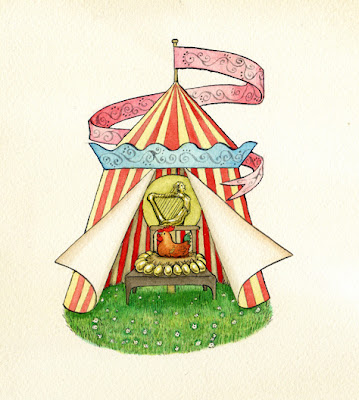 |
| Final page image |
(This post is the English-language transcription of a feature I put together for the October 2012 issue of
Ano Ne magazine in Japan.)
By:
dianalevinart,
on 9/27/2012
Blog:
Creative Zen
(
Login to Add to MyJacketFlap)
JacketFlap tags:
dragon fantasy art,
fairy and dragon,
fairy fantasy art,
fairy prints,
gothic fairy fantasy art,
fairytales,
dragon art,
gothic fairy,
All posts,
gothic fantasy art,
Sale Items,
Add a tag
Fairy and Dragon fantasy art print is a beautiful illustration of a fairy girl holding a baby dragon. She is wearing a purple dress and has pretty purple wings. Is the dragon her pet or her loyal companion? Although the girl is cute, the thorny background suggests that the environment she is standing in is very dangerous.
The print is on 81/2″ x 11″ heavyweight archival matte photo paper with a white 1/2″-1″ border around the image for easy framing
.jpeg?picon=3655)
By: alethea aka frootjoos,
on 8/31/2012
Blog:
Read Now Sleep Later
(
Login to Add to MyJacketFlap)
JacketFlap tags:
BonnevilleBooks,
MelissaLemon,
CinderandElla,
family,
young adult,
book review,
middle grade,
retelling,
sisters,
Fairytales,
3 stars,
2011,
netgalley,
kimberlybuggie,
Add a tag
ISBN 10/13: 1599559064 | 9781599559063
Keywords: Fairy Tale Retelling, Family, Sisters
Category: Young Adult/Middle Grade
Format: ebook, Hardcover
Source: Netgalley
Kimberly's review:I love retellings of my favorite fairy tales, so I've been wanting to read
Cinder and Ella for a while. Cinder and Ella are so close and dependent on each other, that their own family can't tell them apart. When Cinder begins working in the castle, Ella becomes unrecognizable to her family without her other half. Heartbroken, Ella wanders away, searching for a new home and people who will appreciate her. But the castle has dark forces at work and the sisters become the unfortunate target of the handsome, but not so nice prince.
I really like Ella. She's clever, smart and thoughtful. Even in dangerous situations, the girl is a fighter, and I love how strong she is. On the other hand, Cinder is wholesome, good and trusting. Which, honestly, annoyed me to no end. I know, I know. Maybe I'm just cynical. But Cinder is so sweet and pure, she can't even see the evil Prince is, well, evil. I mean really, Cinder? This is me virtually slapping some sense into you.
There.
The writing is sweet, and the style is light and I breezed through this book. I kept wanting to know what happened. The story read like a fairy tale. It is so easy to get swept up in the adventure. Coming in below 300 pages, this super sweet and short tale is perfect for a light read. I especially love the mythology about the trees and how each person has a tree, and it's tied to them. When Cinder and Ella's father runs away, they have a feeling he is still alive because his tree is still alive. Looking worse every year, but alive. And this gives them hope.
But why only three stars you ask? I have a couple of problems with the plot and conclusion of the book. While the ending is tied up rather nicely, Cinder and Ella's family is so selfish and mean, the ending doesn't bring any closure for me. Also, and I won't give it away, the motivations behind some of the characters, especially in the royal family, feel hollow and flimsy.
Overall, Cinder and Ella is a fast, clever retelling of the classic Cinderella story. I think a lot of readers will enjoy Ella and Cinder's adventures.
*I received this book free of charge from the publisher in exchange for an honest review. This, in no way, affected my opinion or review of this book.
Find the author online at
www.authormelissalemon.com and on
Facebook.
You can find more reviews by Kimberly at
www.thewindypages.com and tweet her @
TheWindyPages.
Weeks ago I did a couple posts about the thumbnail process. (Post 1, Post 2)
Now I'll show you how I translate the thumbnail drawing into a sketch that will later be the drawing for the final paining.
There is always a lot of stuff to figure out in the thumbnail process. I decided for this project to go with a portrait orientation because it works better for to format the eBook for all devices. After making that decision it was much easier to work out the composition for each page. (composition= how you arrange the elements on the page)
For example if we take the first part of the Snow-white story the good queen pricks her finger, there are a lot of different ways to show this. Here are some of my ideas. (also seen in previous thumbnail post #2)

I decided to go with the circled one because I liked the gesture and the framing of the queen. I also felt it was a good way to open almost like you are coming into the story through the window. The story doesn't specifically say if the queen is already pregnant but it implies she is and I went with it.
After I get the thumbnail drawing I like I draw it larger. In art school they taught us to create a rough drawing next. Basically a larger version of the thumbnail but still really rough. This process hasn't really worked for me, I needed to be more attached to what I was drawing to get something I liked in the end.
So, I usually jump into what often becomes the finished drawing. But I always have in the back of my mind that I might have to redraw the whole thing. So there is an attachment balance somewhere. I have to love it enough to put my all into the drawing, and be ready to scrap the whole thing if need be.
Here is the finished drawing that goes with this thumbnail.
There is a possibility I will make some slight changes before I go to painting but for the most part this drawing will be what becomes the final art.
Love this art? Buy Prints or Cards and Gifts illustrated by Manelle.
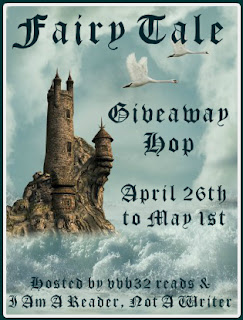
My favorite fairytale right now is The Twelve Dancing Princesses, and my favorite character is the (often nameless) Prince. In some of the older variants he is "the old soldier". The story is about a dozen dancing princesses who are driving their father into penury by constantly wearing out a dozen pairs of shoes every night, to the point where the King has no choice but to lock them up in their bedroom at day's end. Still they somehow are able to wear out their shoes every evening. He offers the hand of any of his princesses to the man who figures out how they are doing this.
The old soldier or prince character, through a mixture of luck and cunning, is able to figure out that every night the girls disappear through a trap door which takes them to a Fairy Ball. They dance the night away and return worn out (shoes, too!) every morning. I love this fairytale even though it seems a bit senseless and without a lesson, because it gives other storytellers free license to imagine a bigger theme and character development, as well as romance, with the fairytale as the framework.
 |
| From Errol le Cain's 1978 adaptation of the tale (photo from Our Paper Moon) |
Today you can win one of these Dancing Princess adaptations:
| | |
|
Here is a quick image of Tolkien's wood elves returning to the undying lands.
Here it is in Black and White.
And just for fun I made it available as a print, laptop skin, or iphone cover at society6.
Love this art? Buy Prints or Cards and Gifts illustrated by Manelle.
Yep, you read right. This is another post about thumbnails. But really they are so important in the process.Here are some more thumbnails I did for my Snow-White eBook project.
As you can or maybe can't see these are just small sketches of the same scene over and over. This is the first scene in the book where the queen pricks her finger and wishes for a black red and white baby. (If you don't know what I'm talking about check it out here.) The boxes with the x are where I plan for text to go in that particular scene. I'm still toying with the landscape or portrait question. I like the idea of it being like a movie (the comment Dashbo made last week) but there are also some neat things I can do with the tall format. In this case maybe an opening scene of the tall castle. But maybe just a scene of the queen will work better. That is what the thumbnails are figuring out for me. While I'm drawing these here is some of the stuff that is going through my head: How much of the queen do I need to show? Will it be better to open with just her? More of the castle, or try to get both? Why is this one working better than that one? Doing this book steam punk could be AWESOME!? How can I do that and keep the fairytale still feeling fairytale-y? Gees I'm going to have to brush up on my perspective to pull this off. What kind of window is she by? Why the heck does she have the window open in the middle of winter... Or is there snow in her house? Some thoughts are useful. Some are well... not so much. But, I can also get lame ideas out of my head with these little drawings. As you can see by the first frame with the super boring composition. I'll probably keep at this for a bit. Maybe with more than one scene in the book before I make any final decisions about how I'll do this scene. Which way to orient the book and how far steam punk to push it. What do you guys think? What's the strongest? How do some of you artists work with thumbnails? Love this art? Buy Prints or Cards and Gifts illustrated by Manelle.
No, I'm not talking about...
I'm talking about... Thumbnails are tiny drawings artists use to help plan an illustration or book before they get into the nitty gritty. Here are two sets that I made for the Snow-white eBook project (see other art for it here) that I have in the works. As you can see they are scribble-y, small, and quick. With these I can see the whole book at a glance and know if one page or a group of pages is going to work. Some of them it might be obvious what is happening in the picture some of them might only make sense to me. Here I am trying to decide first of all which way I want to orient my book. Landscape or portrait? After I decide I'll go in and refine a lot of the scribbles until I have compositions for each picture that are awesome (hopefully) and work with the whole story. Then I start on sketches for "real". What do you guys think should I go with landscape or portrait?
Love this art? Buy Prints or Cards and Gifts illustrated by Manelle.

For the love of words
I was the guest speaker at Meadowcreek Elementary earlier this week. Speaking to hundreds of children at one time is not unusual and it never gets old. I always discuss the following things: the writing process that I personally use, how I got started, my favorite authors, my motivation and inspiration, and of course my characters Lilly, Boris & Jack, from the Mischief series, specifically Mischief in the Mushroom Patch.’ Also, it’s impossible not to mention Pearle, who joins them in ‘A Fairy Match in the Mushroom Patch.’
That day I told the children that when a writer writes a story, they never know who they’re going to touch and I demonstrated my point via Pearle’s story. (It’s beautiful and can be found in an older blog post). Even my latest novel, ‘The Ghost of Whispering Willow’ has a story behind the story. It just seems to work out that way and is often unintentional. I also told them that they shouldn’t worry if other people like their work. It’s their story and it can’t possibly be wrong. If they love their story first, someone else will likely like it. That’s where it all starts, someone liking your story and sharing it with others.
The children are always amazing, each and every one of them. At the end of my presentation, several children wrapped their arms around me and told me that they wanted to be writers too. That’s when I knew that I’d accomplished what I set out to do. Share, inspire, and hopefully motivate the children I spoke with that day.
What I didn’t know during my presentations was that I had caught the attention of several teachers. Many stayed behind to visit, principal included. Three of them were aspiring writers, one was an author, and one wanted to dabble but hadn’t yet taken the first step, which was writing down their fabulous thoughts and ideas. We discussed the market, the changing industry, and starting a writers group. We also talked about the pieces we were currently writing.
Listening to these writers and potential writers, men and women, was refreshing. I understood where they were coming from. I have changed so much over the years. The way I write and my thoughts about writing, even my approach to writing my manuscripts has changed over the years. Growth is a beautiful thing, and something one should never be afraid of. I choose to embrace growth; not to run away from or be afraid of it. Change is often good.
I received beautiful emails that day from several staff members, and invitations to guest speak at other schools that they were affiliated with. I was certain I had done my job with the children, I just had no idea that my words would connect with the adults in the room. It was truly amazing. We all loved the same thing: words. Writers….For the love of words!
 The 'Mischief' series Ugh oh…. I can’t even argue with that!
I have three children and I love them all, but like most kids their personalities are different. My son, the oldest, is figuring his life out and doing a great job. My oldest daughter, well, she’s an over achiever at times but is holding her own. But then there’s my youngest. She challenges me on a daily basis and at times I wonder, “What on earth am I doing wrong?” But she is lovely and most of the time makes me smile.
During our usual drive home I asked the girl’s how their day went, all was well. Out of the blue my youngest said, “Mommy, I have something I need to tell you but you can’t get mad.” I explained that telling the truth was important and that we would discuss once I knew what it was, she agreed to tell me.
“I got kicked out of class today,” she said. “What?” I asked uncertain I’d heard her correctly. She repeated it. “I was kicked out of music class today.” I was shocked, she’s nine. How does a nine year old get kicked out of class? Very calmly I asked her what had happened and she explained. Her explanation put me in a difficult position.
“A kid was playing the flute, really, really bad,” she said. “AND I couldn’t stop laughing because he was soooooo bad.” My face was expressionless as I pictured my daughter trying not to laugh, but knowing my daughter this wasn’t easy for her. She continued her explanation. “My teacher told me to stop laughing,” which was a reasonable request, “But I couldn’t,” she said. Then my daughter continued, “And when my teacher told me to stop again, I said have you heard him? Because he was really bad, but then the boy started to cry and the teacher told me to get out of his class!”
Well I was trying not to laugh. She shouldn’t have laughed at the little boy; that was wrong, but she’s just a little girl and evidently he sounded really bad. I explained to her that laughing at anyone, for any reason wasn’t very nice. I thought the best way to handle the situation was to have her apologize to the boy, her teacher and have her tell her dad when he got home. My daughter decided she would not wait to tell her dad, she wanted to get it over with and proceeded to make a phone call. It did not go as I expected.
She told the story again and concluded with, “And I don’t want a big discussion about this when you get home, because I’ve told you the truth and mom has it covered.” Oh my goodness, what will we do with that one!
Sweetly by Jackson Pearce
ISBN 10/13: 0316068659 | 9780316068659
Category: Young Adult Contemporary Fantasy
Keywords: Fantasy, fairytale, horror,
Format: Hardcover, also available in Kindle format
Thuy's review:
I admit that I had high expectations for Sweetly. Pearce's last book, Sisters Red, was eerie and dark and had me (figuratively) biting my nails. Full of turmoil and deep emotions, could her next book recapture the feeling without treading over the same ground?
Yes, indeed she could. Sweetly is roughly based on the Hansel and Gretel tale by the Grimm Brothers (whose notion of cannibalism always grossed me out). Sweetly's tale begins almost where the classic fairy tale ends, with Ansel, Gretchen and Gretchen's twin sister fleeing through the forest from an evil witch with yellow eyes. Not all of the children make it out of the forest though and Ansel and Gretchen are left with the guilt of losing their sister.
While Ansel has convinced himself that their sister's disappearance was not the work of a witch, Gretchen has not. She's lived in fear since that day, haunted by the yellow eyes of the witch that took her sister and may be coming back for her. Even twelve years later, as she and Ansel make their way to a new city, she can't stop looking over her shoulder and staying away from the dark woods. She soon finds out that the witch in her nightmares is very real and may be closer than she thinks.
I really, really l liked this book. The characters were rich and complex. Most of the story is told from Gretchen's point of view and you can really sense the longing she has to belong and to become her own person instead of the other half of a missing girl. In finding herself, she learns to face her fears and confront the thing that's tormented her for most of her life.
Even though the subject matter is quite dark, there are many funny and light moments. There's a bit of romance thrown in with the dark and brooding Samuel, who has a score to settle. And sweet, sweet Sophia, with her sugary confections and warm smiles but who has secrets of her own. The book is also filled with delicious descriptions of candies and sweets, which is an added bonus for a sugar addict like me.
All in all I thought this was a great read and I can't wait to see what Pearce does next.
.jpeg?picon=3655)
By: Read Now Sleep Later,
on 7/27/2011
Blog: Read Now Sleep Later
( Login to Add to MyJacketFlap)
JacketFlap tags:
Fairytales, 4 stars, Vertigo, revenge, Thuy, BillWillingham, folktales, Siblings, Fables, Add a tag
Peter & Max by Bill Willingham
with illustrations by Steve Leialoha
Publication date: 13 October 2009 by Vertigo
ISBN 10/13: 1401215734 | 9781401215736
Category: Young Adult Fantasy
Format: Hardcover (also available in eBook, Kindle and audiobook)
Keywords: Revenge, Siblings, Fairytales, Folktales, Fables
Peter & Max is a stand alone novel set in the Fables-universe of author Bill Willingham. Fans of Fables will be familiar with the folk and fairy tale personalities that show up in the story. However, those who haven't read the series need not worry. You don't need to be a fan of even very familiar with Fables in order to enjoy the book (though you should be, so do yourself a favor and pick up Fables asap ;).
Peter & Max is the story of Peter and Max Piper of Pied Piper fame. Their entire family is part of a traveling minstrel show. One dark night, soldiers invade their lands the family is torn apart. Alone and scared, Peter becomes a thief to survive. Max, having gone down a dark path, works to perfect his dark magic. He vows that one day, he will find and kill Peter, taking the flute which he believes should have rightfully been passed down to him. Hundreds of years pass and Peter is living a quiet life in a new world with his wife, Bo Peep, when he learns that Max has been spotted. Knowing the death and darkness that Max brings, Peter leaves on a quest to find his long lost brother and end their feud once and for all.
I didn't know much about the legend of the Pied Piper before reading this book. Most of what I remember is from an old Tom & Jerry cartoon. However, I was quickly pulled into the story of Peter Piper and his brother Max. The story shifts perspective between Peter and Max and we see through each of their eyes the events that end up shaping them and eventually pulling them apart. Max's descent into darkness is fascinating to watch and he definitely creeped me out.
Willingham does a fine job of translating the Fables world into a full length book. He blends what we already know about a story with his own ideas so that it is one seamless world. Like many traditional fairy tales, Peter and Max is at times dark and violent. It's a world where wondrous and terrible things happen and where not every ending is a happy one. Lovely black and white illustrations by Steve Leialoha add to its storybook quality. For Fables fans it's a nice addition to the universe. For fans of dark fairy tales or modern retellings of classic tales, it's a quick and fun read.
|


























































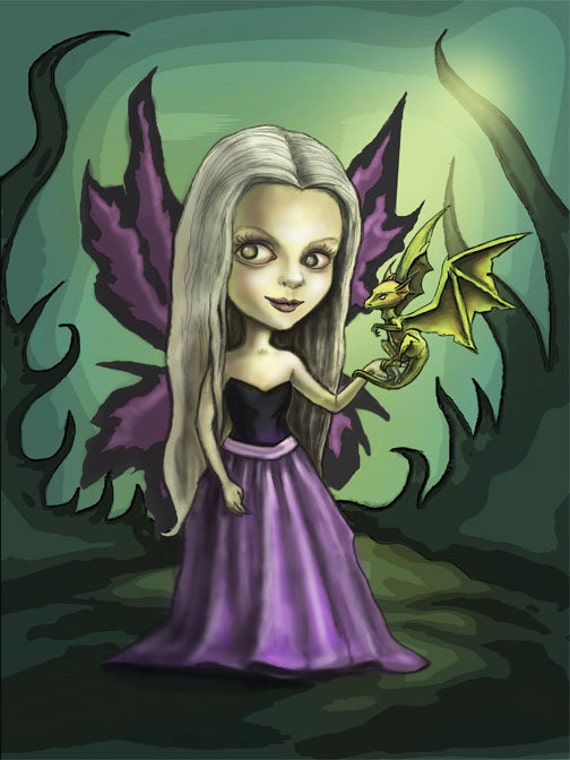
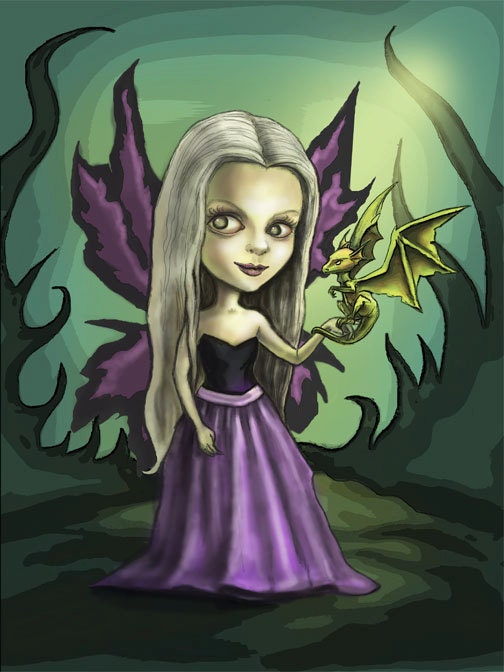
















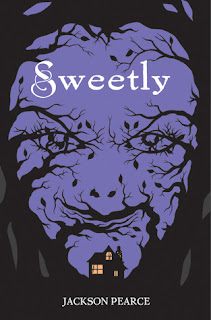

You could write an entire column on “pretty” fairy tales–that is, fairy tales with illustrations that are naturalistic and richly colored. The children in my library love Craft, too, and they love Ruth Sanderson. In my childhood, I loved Adrienne Adams and Tasha Tudor. Gennady Spirin is a fascinating artist, and I’ve never lost my fondness for Errol LeCain. And of course, there’s Paul Zelinsky, who didn’t illustrate a lot of fairy tales, but who did a fabulous job on the ones he did. And of course, there’s Jerry Pinkney, who is both splendid and humane.
But I think Trina Schart Hyman is unsurpassed, even in a field with so many geniuses. Her paintings have so much to offer–sheer lyrical beauty, drama, danger, humor, and excellent characterizations.
I miss her!
I am LOVING these lists!!!!! Thanks so much for all of your hard work putting them together!
I miss her too. Of all the creators of children’s books I missed by a hair, she’s tied with Shel Silverstein. And I adore LeCain! His Twelve Dancing Princesses is still my one and only.
I shall proceed to steal the phrase “splendid and humane” for future use. Thank you for that!
Ahh! Kinuko Craft did my favorite adult book covers of all time, Patricia McKillip’s fantasies (nearly all of them, actually. Hurray to the publisher for keeping the same cover illustrator), but I somehow completely missed the fact that she’d done fairy tales. I will have to scour my library for them.
fyi – i think you threw in an extra “knight” after Xanthe Gresham. I couldn’t figure out why I couldn’t locate the book until I went to the magic of google….
Hm. Well, it’s on the cover and it appear in reviews like this Kirkus one: https://www.kirkusreviews.com/author/xanthe-gresham-knight/
How peculiar!